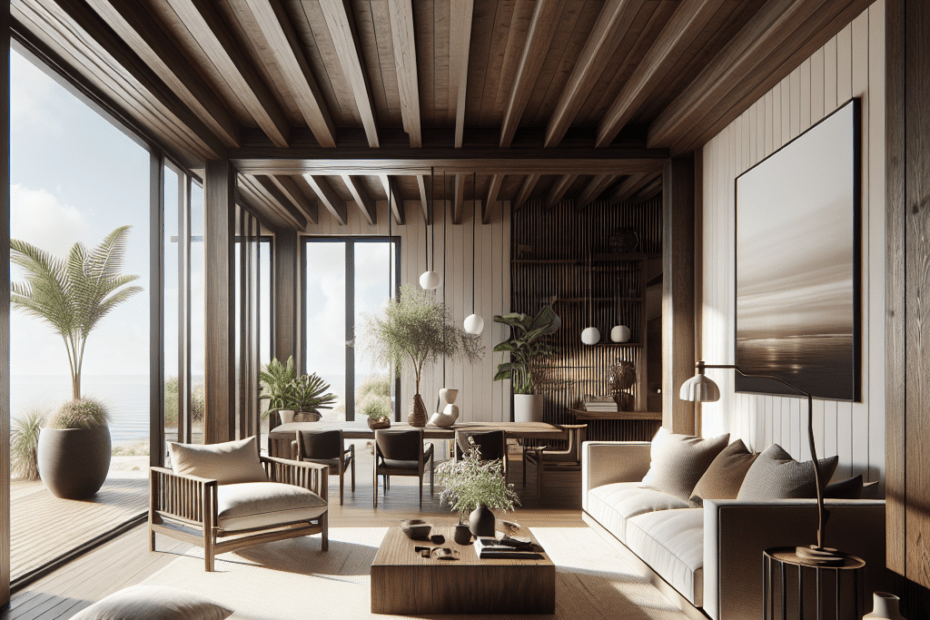“`html
In recent years, they have seen a growing trend in home design: the use of dark wood in coastal interiors. This unexpected yet bold design choice is reshaping how people envision their seaside spaces. As more homeowners experiment with design, dark wood in coastal design is making a splash with its rich hues and elegant contrasts. While lighter woods like oak and pine have traditionally dominated coastal themes, dark wood adds depth and sophistication that’s hard to ignore.
Dark wood, with its deep tones and luxurious feel, creates a lovely contrast to the airy, relaxed vibe. Many designers and homeowners have started embracing dark wood elements in furniture, flooring, and accents, setting a striking foundation for décor that captures both warmth and sophistication. According to a study by HomeDesignTrends in 2023, approximately 34% of coastal homes now incorporate dark wood elements compared to just 19% in 2020.
Design Elements and Characteristics
Dark wood such as mahogany, walnut, and cherry brings a sense of richness and stability to interiors. They have noticed its ability to harmonize with the whites, creams, and blues often found in coastal homes. The key is to balance these deep tones without overpowering the lightness typically desired in seaside retreats. By combining sleek dark wood furnishings with light textiles and bright accessories, homeowners can achieve a balanced look that feels both fresh and grounded.
| Wood Type | Characteristic | Compatibility |
|---|---|---|
| Mahogany | Rich texture with a red undertone | Best with whites and neutrals |
| Walnut | Smooth with natural patterns | Pairs well with blues and greens |
| Cherry | Warmth with striking grain patterns | Complements pastels and creams |
Advantages of Using Dark Wood
Dark wood in coastal design doesn’t just bring aesthetic appeal; it offers several practical benefits. Firstly, dark woods are often more durable than their lighter counterparts, translating to long-lasting furniture and finishes that withstand the test of time. Additionally, these woods are excellent at hiding scratches and wear, making them ideal for high-traffic areas like living rooms and kitchens.
Furthermore, dark wood can add value to a home. A report by Coastal Living found that homes using darker woods in their design saw a 10% increase in resale value compared to those that stuck solely to traditional light woods. This shift indicates that potential buyers are now seeking bolder, more refined interiors even in coastal locations.
Tips for Incorporating Dark Wood
For those ready to dive into the trend, it’s essential to incorporate dark wood thoughtfully. They suggest starting with smaller pieces, such as a coffee table or sideboard, to gauge its impact before committing entirely. Layering bold, dark wood with light fabrics and metallic accents can also prevent the room from feeling too heavy.
Creating a focal point with dark wood can be highly effective. A beautifully crafted dark wood dining table or an eye-catching cabinetry in the kitchen can serve as the centerpiece. It’s also wise to consider natural light—pairing dark wood with ample sunlight can maintain a sense of openness despite the dramatic tones.
Key Takeaways
- Dark wood in coastal design offers a rich, sophisticated contrast to traditional light-themed coastal interiors.
- Using dark wood can increase a home’s durability and potentially its resale value.
- Balance is crucial; combining dark wood elements with lighter hues ensures a fresh, welcoming atmosphere.
- Starting small with dark wood pieces can help homeowners find the right mix for their space.
FAQ
- 1. Can dark wood in coastal design work in small spaces?
- Yes, when used carefully with ample lighting and contrast, dark wood can make small spaces appear elegant without feeling cramped.
- 2. What types of dark wood are recommended for coastal designs?
- Mahogany, walnut, and cherry are popular choices for their beauty and compatibility with coastal color schemes.
- 3. How can homeowners prevent a room with dark wood from looking too heavy?
- Incorporating light textiles, reflective surfaces, and maintaining balance with other décor elements prevents a heavy look.
- 4. Is dark wood more expensive than light wood?
- While some dark wood varieties may be more expensive due to their quality, the investment often translates to longer-lasting furniture.
- 5. Are there other benefits of using dark wood aside from aesthetics?
- Yes, dark wood is generally more durable than light wood and tends to conceal wear and scratches better.
“`
